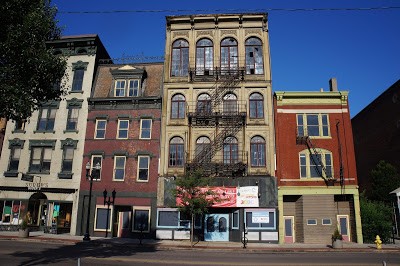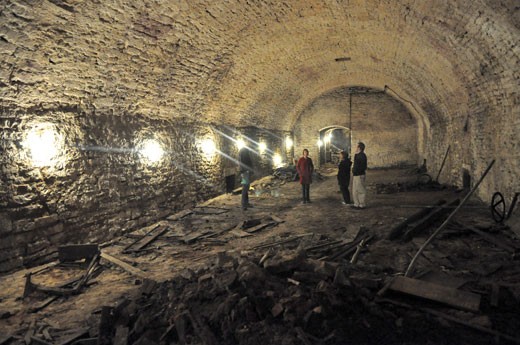Cosmopolitan Hall
Introduction
Text-to-speech Audio
Cosmopolitan Hall is a large structure in Over the Rhine, Cincinnati, that has been used as a gathering hall of various sorts since it was built in 1855. The building is estimated to have a total area of 27,000 square feet. Throughout its history, Cosmopolitan Hall has been known as Saenger Hall, the Tivoli Beer Garden at 1313 Vine, Music Hall, Germania Hall, Union Hall, New Lincoln Hall, and The Warehouse. It originally served as a beer garden and dance hall. At other times, it functioned as a meeting space for labor unions and local societies, an event space for balls and lectures, and a dance club. It currently serves as a shared workspace for local startups and entrepreneurs under the name of "Union Hall.”
Images
1313 Vine Street

View of one of the upper floors, looking toward the front of the building

Barrel-vaulted catacomb in the basement of Cosmopolitan Hall

Dance hall in Cosmopolitan Hall taken in the 2000s.

1887 Sanborn Insurance Map of Cosmopolitan Hall

Backstory and Context
Text-to-speech Audio
Cosmopolitan Hall was built at the site of a small brewery called Cincinnati Brewery, established by a man named Peter Noll around 1850. When Noll built the Hall five years later, he included a giant barrel-vaulted catacomb in the basement that stretches across the entire block, from Republic St. to Vine.
Management of the hall changed hands many times in its early years. In 1859, the hall was used as a “coffee house” managed by Jacob F. Flattich. In 1863, the owner was listed as Peter Dilg, who operated the hall as a saloon before handing the building over to Edward Koppe. Operation of the building was carried out by at least three different men throughout the 1870s, and during this time the hall also began to be utilized formally as a meeting space for various local societies with names such as “the Good Fellows,” “The Germania Encampment,” and “Seven Wise Men.”
In the 1880s, the hall was known as “Central Union Hall,” and continued to function as a meeting space for local societies as well as several labor unions such as the Bricklayers Union and the Brotherhood of Painters and Decorators.
In 1897, the building was taken over by Wendel Meyers and renamed Cosmopolitan Hall, which stuck until the 1940s. Meyers had the building’s interior remodeled and added 6 bowling lanes, while also keeping the hall open as a multi-use gathering space and event hall for local organizations.
Throughout the late 1890s and early 1900s, the hall was utilized by organizations of capitalists (such as the Cincinnati Retail Grocer’s Association) and labor unions (such as the Iron Molder’s Union and the Potter’s Union) alike. In addition, the space was used by mutual aid societies (such as the Order of Mutual Protection) and fraternity and sorority clubs (such as the Knights of Honor and the Schwestern Bund Unterstuetzungs Verein).
According to a book written by the Federal Writer's Project about Cincinnati, Cosmopolitan Hall was a common meeting spot for people of all nationalities during these years, regularly hosting immigrant weddings and other events. "On Saturday nights the building shook with the colorful, athletic dances given by various benefit fraternities. From time to time the music of nearly every European people had its innings here, and Magyar, Slav, and Teuton spoke with an abandon that was startling to the casual outsider."
The hall was passed over to Frank Duttenhofer when Meyers died in 1910. In the 1920s, the hall operated as a speak easy through Prohibition. The hall changed hands again in 1930 to Joseph Rosenberger, who added indoor golfing facilities by the name of “Coral Gables.” By 1947, the hall had become Bellonby Furniture Store, and by 1956 was utilized by Welsbach Sales Company, an electrical equipment supply store.
In 1990, the film A Rage in Harlem was filmed inside the hall, and in 1992, a nightclub named The Warehouse began operations in the building. The Warehouse became a well-known dance club in the Cincinnati goth and alternative scenes until it closed in 2004.
In 2006, the building was purchased by 3CDC, an urban renewal nonprofit in Over the Rhine and downtown Cincinnati. 3CDC stabilized the building, which had previously fallen into disrepair. The hall was opened up for ghost tours with American Legacy Tours, who claimed to experience paranormal activity within the building. Eventually, the building was gutted and remodeled as office space for Centrifuge for a cost of $17 million. Since 2015, it has operated under the name of Union Hall as a shared workspace for local businesses, entrepreneurs, and startups.
Prominent Events at Cosmopolitan Hall:
Cosmopolitan Hall hosted several prominent lecturers and large events during its time as a community gathering space.
In 1902, Cosmopolitan Hall was set to host Mother Jones, the popular labor union activist, to give a speech in support of a strike staged by the anthracite miners. To the disappointment of thousands of people who had assembled for the speech, Mother Jones was unable to be present at the event due to unforeseen circumstances. However, the event still went on as planned. Admission was free, but donations were collected in support of the miners. About 45 members from the Musicians’ Protective Association donated their services to the event, including a famous boy cornetist named “Master” Harry Kahn. One of the speakers at the event, Mr. Fredrick G. Strickland of the local Cigar Maker’s Union, advocated for ownership and operation of the mines by the people.
In 1903, the Musicians’ Union of Cincinnati held a tribute lunch event to Mozart in memory of his birthday at Cosmopolitan Hall. One string quintet of Mozart’s was played, and the rest of the program included impromptu numbers described by the Cincinnati Enquirer as “not only clever and artistic, but in some respects very amusing.” Over 30 well-known musicians participated in the event, many of them belonging to the Symphony Orchestra. The hall was full of people and described as a great success, with “frequent and enthusiastic” applause.
In 1907, the well-known anarchist Emma Goldman spoke at Cosmopolitan Hall. Her speech was made in German to a mixed audience of social democratic and radical socialists and anarchists. Goldman spoke about the failures of political parties to accomplish reforms desired by the working classes, citing the failures of the Socialist part in Germany, the Populist Party in the USA, and the Conservative Party in Russia. Goldman advocated for the mass uprising of people, which she stated was the only way to force the governing class, “willing or unwilling,” to bow to the will of the people. Goldman also criticized labor unions’ tendencies to adhere to arbitration agreements made with management, and to give employers long notice in advance of proposed strikes. “No general in the field at the head of a great army," she said according to the Cincinnati Enquirer, “ever gave the opposing forces notice of when or where he intended to strike a blow, and the same tactics should be the policy of a civil army or its leaders when they want reforms in government.”
The Itinerant Workers of the World Union, Hoboes of America, held their national conference at Cosmopolitan Hall in 1913. This union organized for the rights of homeless migrants and the unemployed by fighting against abuses by employment agencies and anti-vagrancy laws. At the 1913 convention, members of the union voted to never act as strikebreakers. The hoboes had planned to hold a parade at the conclusion of the convention to “show people the difference between a tramp, a hobo, and a bum.” When the Cincinnati Chief of Police forbade the parade from taking place, the hoboes objected to the decision by claiming their parade was perfectly constitutional, but still followed the orders from the chief “to prove that the hoboes knew how to respect the law, even if the law did not respect them.”
Several strikes were organized and staged out of Cosmopolitan Hall, including a strike in 1913 by the Street Railway Men’s Union. This strike was supported by the Central Labor Council, which acted as a “union of unions” in Cincinnati.
Sources
"About." UnionHallCincy.com. Accessed 09 July 2021. <https://unionhallcincy.com>
“CHICAGO: CHOSEN BY HOBOES FOR NEXT CONVENTION--CINCINNATI IS MADE…” Cincinnati Enquirer (1872-1922); Aug 9, 1913; ProQuest Historical Newspapers: The Cincinnati Enquirer pg. 18
cincyhistorylvr. "The History and names of 1313 Vine Street." Digging Cincinnati History. 14 January 2014. Accessed 09 July 2021. <http://www.diggingcincinnati.com/2014/01/the-history-and-names-of-1313-vine.html>
Cincinnati: A Guide to the Queen City and Its Neighbors. United States, Wiesen-Hart Press, 1943.
“The Cosmopolitan.”
Cincinnati Enquirer (1872-1922); Jun 12, 1897; ProQuest Historical Newspapers: The Cincinnati Enquirer pg. 16
Coston, Casey. "Soapdish: revisiting 1313 Vine, from beer hall to nightclub to entrepreneur hub and beyond." Soapbox Cincinnati. 28 March 2017. Accessed 09 July 2021. <https://www.soapboxmedia.com/features/032817-1313-vine-street-adaptive-reuse-soapdish.aspx>
“EMMA GOLDMAN.: NOTED ANARCHIST LECTURER, DERIDES POLITICAL PARTIES." Cincinnati Enquirer (1872-1922); Apr 1, 1907; ProQuest Historical Newspapers: The Cincinnati Enquirer pg. 10
“DISAPPOINTED: WAS LARGE AUDIENCE THAT ASSEMBLED TO HEAR "MOTHER" ... “
Cincinnati Enquirer (1872-1922); Oct 17, 1902; ProQuest Historical Newspapers: The Cincinnati Enquirer pg. 7
“HOBOES: WILL OPEN THEIR NATIONAL CONVENTION HERE THIS MORNING…” Cincinnati Enquirer (1872-1922); Aug 5, 1913; ProQuest Historical Newspapers: The Cincinnati Enquirer pg. 16
“HOBOES: HOLDING ANNUAL MEET TO DISCUSS THE GRIEVANCES OR THE ... “ Cincinnati Enquirer (1872-1922); Aug 6, 1913; ProQuest Historical Newspapers: The Cincinnati Enquirer pg. 8
“”MOTHER" JONES: WILL SPEAK ON THE STRIKE AT…” Cincinnati Enquirer (1872-1922); Oct 16, 1902; ProQuest Historical Newspapers: The Cincinnati Enquirer pg. 12
“ORGANIZED LABOR: AT MASS MEETING PLEDGES STRIKERS MORAL AND FINANCI…” Cincinnati Enquirer (1872-1922); May 19, 1913; ProQuest Historical Newspapers: The Cincinnati Enquirer pg. 2
“PARADE: OF HOBOES FORBIDDEN BY CHIEF COPELAN--CONVENTION ADOPTS CON…” Cincinnati Enquirer (1872-1922); Aug 8, 1913;ProQuest Historical Newspapers: The Cincinnati Enquirer pg. 14
Rick. "Cosmopolitan Hall (The Warehouse Nightclub)." Creepy Cincinnati. 16 November 2011. Accessed 9 July 2021. <https://creepycincinnati.com/2011/11/16/cosmopolitan-hall-the-warehouse-nightclub/>
Steinert, Anne. Labor History Walking Tour — Over the Rhine Museum. Cincinnati, OH. 04 November, 2019.
"TRIBUTE TO MOZART.: GREAT COMPOSER'S BIRTHDAY CELEBRATED BY LOCAL..." Cincinnati Enquirer (1872-1922); Jan 28, 1903; ProQuest Historical Newspapers: The Cincinnati Enquirer pg. 12
"VOICE: OF ORGANIZED LABOR RAISED IN PROTEST AGAINST JUDGE WRIGHT'S ..." Cincinnati Enquirer (1872-1922); Jan 20, 1909; ProQuest Historical Newspapers: The Cincinnati Enquirer pg. 2
3CDC
Nathan Hammitt, OTR Blog
Scott-Beseler for Soapbox
Nathan Hammitt, OTR Blog
http://www.diggingcincinnati.com/2014/01/the-history-and-names-of-1313-vine.html
